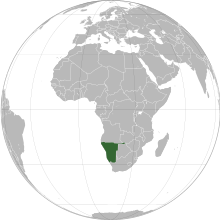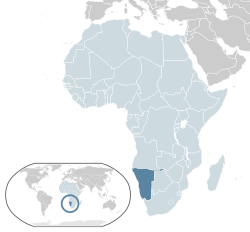
Back Намибиа Abkhazian Namibia ACE Намибие ADY Namibië Afrikaans Namibia ALS ናሚቢያ Amharic Namibia AMI Namibia AN Namibia ANG नामीबिया ANP
Republic of Namibia | |
|---|---|
| Motto: "Unity, Liberty, Justice" | |
| Anthem: "Namibia, Land of the Brave"
| |
| Capital and largest city | Windhoek 22°34′S 17°5′E / 22.567°S 17.083°E |
| Official languages | English |
| Recognised national languages | |
| Recognised regional languages | |
| Ethnic groups (2014) | |
| Religion (2013)[9] |
|
| Demonym(s) | Namibian |
| Government | Unitary semi-presidential republic[10] |
| Nangolo Mbumba | |
| Netumbo Nandi-Ndaitwah | |
| Saara Kuugongelwa | |
| John Mutorwa | |
| Peter Shivute | |
| Legislature | Parliament |
| National Council | |
| National Assembly | |
| Independence from South Africa | |
| 09 February 1990 | |
| 21 March 1990 | |
| Area | |
• Total | 825,615 km2 (318,772 sq mi) (34th) |
• Water (%) | negligible |
| Population | |
• Census | 3,022,041[11] |
• Density | 3.7/km2 (9.6/sq mi) (235th) |
| GDP (PPP) | 2023 estimate |
• Total | |
• Per capita | |
| GDP (nominal) | 2023 estimate |
• Total | |
• Per capita | |
| Gini (2015) | 59.1[13] high |
| HDI (2022) | medium (142nd) |
| Currency | Namibian dollar (NAD) South African rand (ZAR) |
| Time zone | UTC+2 (CAT) |
| Date format | dd/mm/yyyy |
| Driving side | left |
| Calling code | +264 |
| ISO 3166 code | NA |
| Internet TLD | .na |
Namibia (/nəˈmɪbiə/ ⓘ, /næˈ-/),[15][16] officially the Republic of Namibia, is a country in Southern Africa. Its western border is the Atlantic Ocean. It shares land borders with Angola and Zambia to the north, Botswana to the east and South Africa to the east and south. Although it does not border Zimbabwe, less than 200 metres (660 feet) of the Botswanan right bank of the Zambezi River separates the two countries. Its capital and largest city is Windhoek.
The driest country in sub-Saharan Africa,[17] Namibia has been inhabited since pre-historic times by the Khoi, San, Damara and Nama people. Around the 14th century, immigrating Bantu peoples arrived as part of the Bantu expansion. Since then, the Bantu groups, the largest being the Ovambo, have dominated the population of the country; since the late 19th century, they have constituted a majority. With a population of 3,022,401 people today, Namibia is one of the most sparsely populated countries in the world.
In 1884, the German Empire established rule over most of the territory, forming a colony known as German South West Africa. Between 1904 and 1908, German troops waged a punitive campaign against the Herero and Nama which escalated into the first genocide of the 20th century. German rule ended during the First World War with a 1915 defeat by South African forces. In 1920, after the end of the war, the League of Nations mandated administration of the colony to South Africa. From 1948, with the National Party elected to power, this included South Africa applying apartheid to what was then known as South West Africa. In the later 20th century, uprisings and demands for political representation by native African political activists seeking independence resulted in the United Nations assuming direct responsibility over the territory in 1966, but the country of South Africa maintained de facto rule. In 1973, the UN recognized the South West Africa People's Organization (SWAPO) as the official representative of the Namibian people. Namibia gained independence from South Africa on 21 March 1990, following the Namibian War of Independence. However, Walvis Bay and the Penguin Islands remained under South African control until 1994.
Namibia is a stable parliamentary democracy. Agriculture, tourism and the mining industry – including mining for gem diamonds, uranium, gold, silver and base metals – form the basis of its economy, while the manufacturing sector is comparatively small. Despite significant GDP growth since its independence,[18] poverty and inequality remain significant in the country. 40.9% of the population is affected by multidimensional poverty[19] and more than 400,000 people continue to live in informal housing.[20] Income disparity in the country is one of the world's highest with a Gini coefficient of 59.1 in 2015.[21]
Namibia is a member state of the United Nations, the Southern African Development Community, the African Union and the Commonwealth of Nations.
- ^ "Communal Land Reform Act, German" (PDF). Government of Namibia. Retrieved 18 February 2016. [permanent dead link]
- ^ "Communal Land Reform Act, Afrikaans" (PDF). Government of Namibia. Archived from the original (PDF) on 25 February 2016. Retrieved 18 February 2016.
- ^ "Communal Land Reform Act, Khoekhoegowab" (PDF). Government of Namibia. Archived from the original (PDF) on 25 February 2016. Retrieved 18 February 2016.
- ^ "Communal Land Reform Act, Oshiwambo" (PDF). Government of Namibia. Archived from the original (PDF) on 1 March 2016. Retrieved 18 February 2016.
- ^ "Communal Land Reform Act, Otjiherero" (PDF). Government of Namibia. Retrieved 18 February 2016. [permanent dead link]
- ^ "Communal Land Reform Act, Rukwangali" (PDF). Government of Namibia. Archived from the original (PDF) on 25 February 2016. Retrieved 18 February 2016.
- ^ "Communal Land Reform Act, Setswana" (PDF). Government of Namibia. Archived from the original (PDF) on 25 February 2016. Retrieved 18 February 2016.
- ^ "Communal Land Reform Act, Lozi" (PDF). Government of Namibia. Archived from the original (PDF) on 25 February 2016. Retrieved 18 February 2016.
- ^ "Namibia Demographic and Health Survey 2013" (PDF). The Namibia Ministry of Health and Social Services (MoHSS) and ICF International. September 2014. p. 30. Retrieved 5 July 2021. Only people between 15 and 49 years of age were surveyed.
- ^ Cite error: The named reference
Dualwas invoked but never defined (see the help page). - ^ "Namibia". The World Factbook (2024 ed.). Central Intelligence Agency. Retrieved 22 June 2023.
- ^ a b c d "World Economic Outlook Database, October 2023 (Namibia)". IMF.org. International Monetary Fund. 10 October 2023. Retrieved 18 October 2023.
- ^ "GINI index (World Bank estimate)". data.worldbank.org. World Bank. Retrieved 20 January 2019.
- ^ "Human Development Report 2023/2024". United Nations Development Programme. 19 March 2024. Retrieved 19 March 2024.
- ^ Wells, John C. (2008), Longman Pronunciation Dictionary (3rd ed.), Longman, ISBN 978-1405881180
- ^ Roach, Peter (2011), Cambridge English Pronouncing Dictionary (18th ed.), Cambridge: Cambridge University Press, ISBN 978-0521152532
- ^ Peter Shadbolt (24 October 2012). "Namibia country profile: moving on from a difficult past". CNN.
- ^ "World Bank Open Data". World Bank Open Data. Retrieved 3 April 2024.
- ^ "Multidimensional Poverty Index 2023" (PDF). United Nations Development Programme Human Development Reports. 2023. Retrieved 3 April 2024.
- ^ "Namibia's ghetto life: Half million live in shacks countrywide - The Namibian". 12 March 2021. Archived from the original on 12 March 2021. Retrieved 3 April 2024.
{{cite web}}: CS1 maint: bot: original URL status unknown (link) - ^ "World Bank Open Data". World Bank Open Data. Retrieved 3 April 2024.



